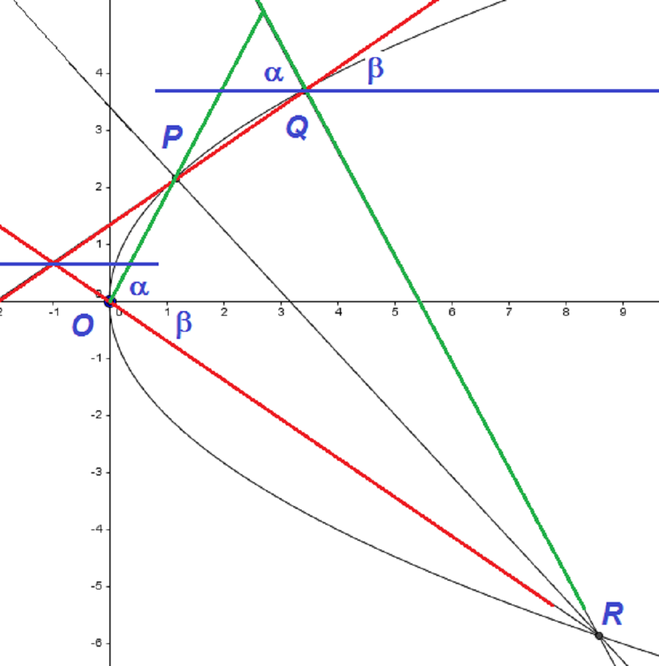Find the equation of the normal to the parabola \(y^2=4ax\) at the point \((at^2,2at)\).
Taking the derivative of the equation \(y^2=4ax\) with respect to \(x\) we find that \[2y\frac{dy}{dx}=4a \qquad \Longrightarrow \qquad \frac{dy}{dx}=\frac{2a}{y}=\frac{2a}{2at}=\frac{1}{t}.\] The gradient of normal to the parabola at the point \((at^2,2at)\) is therefore \(-t\) since \[\frac{1}{t}\times -t=-1.\] The equation of the normal is then \[y-2at=-t(x-at^2) \qquad \Longrightarrow \qquad y=-tx+2at+at^3.\]
The parameters of the points \(P\), \(Q\) are \(t_1\) and \(t_2\) respectively. Show that, if \(PQ\) passes through the point \((-2a,0)\), then \(t_1t_2=2, ...\)
as required.
…and the normals at \(P\) and \(Q\) to the parabola meet at a point \(R\) on the parabola.
Thus \(R=\left(a(t_1+t_2)^2,-2a(t_1+t_2)\right)\), and comparing this to the general point on the parabola \((at^2,2at)\), we can see that \(R\) is clearly on the curve.
If \(O\) is the origin, show, by considering the gradients of the sides of the quadrilateral \(OPQR\) or otherwise, that the circumcircle of the triangle \(PQR\) passes through \(O\).
Since \(P = (at_1^2, 2at_1)\), \(Q = (at_2^2, 2at_2)\), \(R = (a(t_1+t_2)^2, -2a(t_1+t_2))\), and \(O = (0, 0)\), then:
\(OP\) has gradient \(\dfrac{2}{t_1}\), \(PQ\) has gradient \(\dfrac{2}{t_1+t_2}\), \(QR\) has gradient \(-\dfrac{2}{t_1}\), while \(RO\) has gradient \(-\dfrac{2}{t_1+t_2}\).

Thus \(OP\) and \(QR\) are reflections of each other in a vertical or horizontal line, and \(PQ\) and \(OR\) are likewise.
The diagram shows that angle \(\widehat{PQR}\) is \(180^\circ-\alpha -\beta\), and so the angles \(\widehat{POR}\) and \(\widehat{PQR}\) add to \(180^\circ\), and therefore \(OPQR\) is a cyclic quadrilateral.
Thus \(O\) lies on the circumcircle of \(PQR\), as required.

